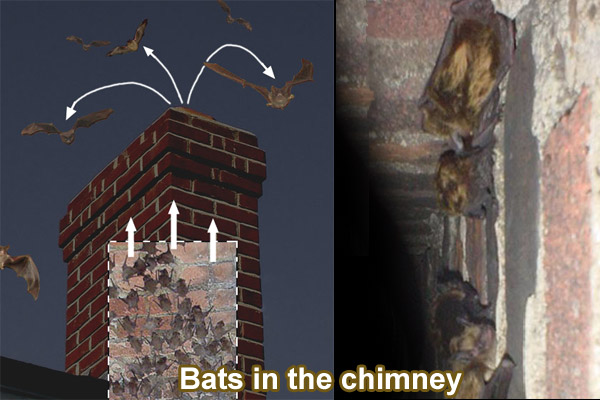The three most common colonizing bat species in the USA that enter and live in buildings are:
Little Brown Bat (northern states)
Big Brown Bat (all over)
Brazilian Freetail Bat (southern states)
How to remove bats from a chimney - When it comes to bats living in your house, a clove of garlic and a silver cross just isn’t going to cut it. These aren’t the menacing creatures you see in films and on the TV – they are fragile creatures that are just looking for some place to call home. Believe it or not, they haven’t moved into your chimney to annoy you.

Removing a colony of bats is a hard task because they tend to prefer places that are rather high up in your house – usually chimneys, attics and rafters. This makes it difficult to you because you will usually have to climb your way, Spiderman style, to get to wherever it is they are hiding. There are a number of methods that you can use to safely evict the bats from your chimney without putting them or yourself in danger, and these include a regime of making a way for the bat to exit your home, but not return; closing up the holes they were using once they have left.
You’re going to want to take a good look around your chimney – there will probably be more than one hole that they are using to gain access to your home. You may think that the easiest way to remove these critters would be by turning the fire on and letting the fumes push them out, but this is not only cruel, but rather stupid – you don’t what could happen. Ideally, you are going to want to minimize the amount of holes in the chimney that you can find. When you block up the holes they are using, you should try and do so with some sort of caulking that is water-based rather than the expanding foam stuff. The latter can cause the bats to become stuck when they are trying to exit and then you are going to have dead bats on your hands.
The whole process behind removing bats from a chimney is called exclusion – you basically want to get all bats out of the hole they have crawled in, and then block it up so that they cannot return at a later date. This can be difficult for a few reasons. Firstly, they may not be exiting and entering your home all at the same time. Secondly, there may be more than one hole that they are using. This is why you want to start blocking up the smaller holes first; the ones that look as if they are not being used that much at all. Once you start blocking up the smaller holes, they will be more inclined to start using the same hole, and this will make the exclusion process a much easier one.
Ideally, the best thing to do is to hire a professional. Do you really want to be crawling up and down a ladder with sealing foam or caulking, and attempting to make the funniest videos section of America’s Funny Home Videos? There are so many things to take into account, other than pretending to be Spiderman for the day. You are going to need thick gloves. The chances of you getting rabies are rare, but you don’t want to take the chance. You don’t know how the creatures will react either – they could get vicious with you. You are invading their home, remember?
Also, you are going to need to find a new home for the bats that you are evicting out of your chimney. It is all very good and well getting them out of your home, but they have to live somewhere and if they have already classed your attic or chimney as your home once before, there is a good chance that they are going to try and do it again. Many people find that building a bat house outside in the yard can help with this, and although it means the bats are still living on your property, they are not living and pooping in your home – that’s a good thing!
Go back to the
How Do You Get Rid of Bats in Buildings home page.